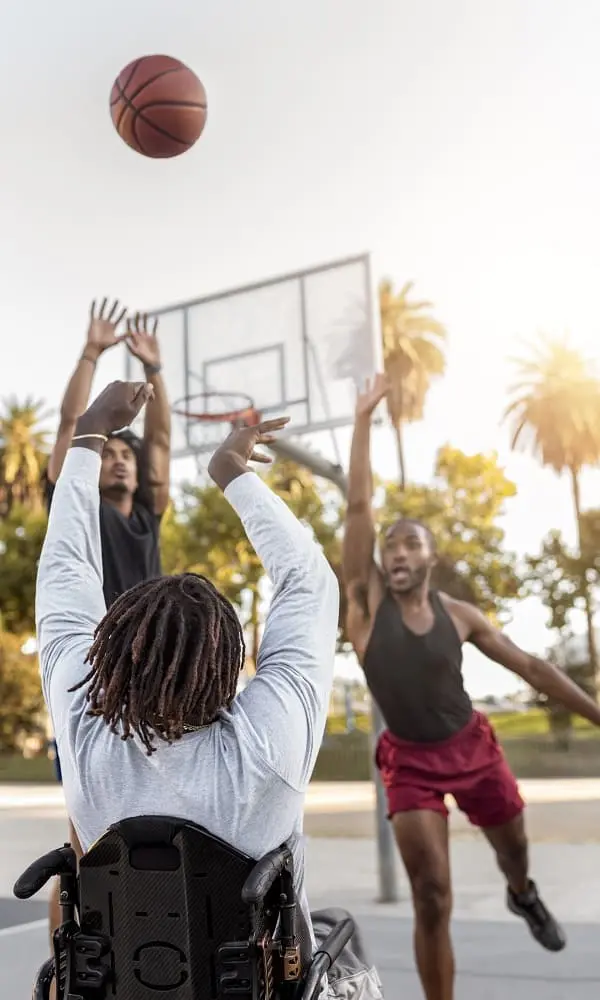Content
Basketball is a team sport played between two teams of five players each. The aim is to score points by passing the ball through a basket located 3.05 meters above the ground.
Have you ever wondered why there are exactly five players on each team? Do you know the rules that determine the number of players on the court, the structure of a professional basketball team, the different positions and functions of each player?
This article aims to demystify these issues. We’ll look at the basic rules relating to the number of players in basketball, the structure of a professional basketball team, the different positions on the court and the role of each player.
Finally, we’ll introduce you to some of the legendary teams that have marked the sport’s history.

How many players does a basketball team have?
Traditional basketball requires each team to have five players on the court simultaneously, occupying specific positions. Each position plays a key role in the team’s success.
How does the team choose its starting players? What are the possibilities for substitution during the match? And how does the number of players affect game strategy? Let’s take a look at these questions.
What is the major 5?
The major five refers to the players who start the match. Their selection, made by the coach, depends on criteria such as physical condition, the complementary nature of the players, the style of play and the opposing team. This selection can vary from match to match, depending on the team’s strengths and weaknesses.
For example, a team focused on speed and long-range shooting will prefer smaller, less agile players, while a team focused on the inside game will choose taller, more robust players.
Substitutions and time-outs
In addition to the five starters, a team also has a number of reserve players who can be called upon to play at any time. The number of substitutes varies according to league and level of competition, generally between 5 and 10. Free substitutions are made during stoppages in play, fouls or when the ball is not in play.
They allow the coach to rest his players and adjust his strategy according to the evolution of the score or the opponent.
For example, a substitution can be made to strengthen the defense against a strong opponent, or to increase attacking capacity to make up for a deficit.
Winning strategies for different basketball positions
The configuration of the number of players in play greatly influences a team’s strategy, influencing the number of passes, shots, rebounds and oppositions possible.
A numerical advantage increases space, diversifies play options and intensifies pressure on the opponent. Conversely, a numerical disadvantage forces you to adopt a more defensive approach, minimize risks and look for the best scoring opportunities.
Variations in the number of players may occur as a result of technical or disqualifying fouls, leading to the temporary or permanent exclusion of a player. In such cases, the affected team must adapt its strategy and show solidarity to overcome its numerical inferiority.
What is the composition of a professional basketball team?
A professional basketball team is made up of players, coaches and technical staff, all of whom are essential to its participation in top-level competitions.
Their numbers and functions vary according to the rules of the different leagues (NBA, FIBA, NCAA), but typical patterns emerge in terms of structure.
Here, we explore these typical models and their possible variations, focusing in particular on the NBA, the world’s most emblematic and closely followed league.
Typical structure of major leagues (NBA, FIBA, NCAA)
In the major basketball leagues, a team generally consists of between 12 and 15 players, including 5 starters and up to 10 substitutes.
Players occupy one of five key roles on the court: point guard, guard, wing, power forward and pivot, each requiring specific physical, technical and tactical skills. The point guard orchestrates the attack and distributes play, while the pivot, often the most imposing player, dominates near the basket for rebounding and defending the circle. Positions on the court are often identified by numbers from 1 to 5, according to the increasing size of the players.
The team’s technical direction is the responsibility of a head coach, supported by various assistants (defense, shooting, scouting, player development) and a technical staff made up of professionals in care, physical preparation and video analysis, among others.
Variations according to competition levels and rules
The format and roles of professional basketball teams can vary according to the level of competition and the specific rules of each league.
For example, the NCAA allows up to 18 players per team, while competitions such as the Olympic Games or World Championships limit the number of players to 12.
Some national legislations or leagues may impose recruiting restrictions based on player nationality, or impose a salary cap to ensure financial equity between teams.
Focus on NBA
The NBA is basketball’s most prestigious and popular league. It features 30 teams divided into two conferences. Each team plays 82 regular-season games before eventually competing in the playoffs for the Larry O’Brien trophy.
The NBA has the distinction of limiting rosters to 15 players, 13 active and 2 inactive, with the possibility of signing two-way contracts for greater flexibility between the NBA and the G-League.
Subject to a strict salary cap, franchises have certain exceptions that allow them to exceed it under specific conditions.
They are also active on the transfer market, with the possibility of trading players, recruiting free agents, waiving certain contracts or using the amnesty clause to adjust their workforce and financial strategies.

What are the different basketball positions and their roles?
In basketball, the allocation of specific positions and roles to each player depends on his or her physical abilities, technical skills and tactical understanding of the game.
These positions and roles are essential to the cohesion and effectiveness of a team, even if they can be adapted as the game evolves.
In this section, we explore traditional positions, the adaptation of roles to modern basketball and the growing importance of player versatility in today’s game strategies.
What are the 5 positions in basketball?
There are five traditional positions on a basketball team: point guard (position 1), shooting guard (position 2), small forward (position 3), power forward (position 4) and center (position 5). Each has specific functions on the court, detailed as follows:
- Point guard, he coordinates the attack, distributes the ball, creates openings and communicates with his team and the coach. His talents include good vision of the game, precise dribbling, efficient passing and, if possible, a good shot. He also defends the opposing playmaker and anticipates attacks to organize the defense.
- Shooting guard, his main role is to score points, with three-point, mid-range or penetration shots. He must possess excellent shooting skills, skilful dribbling, speed and notable explosiveness. He is also responsible for defending the opposing back line, and can help move the ball around.
- Small forward, he is the ultimate all-rounder, capable of playing both inside and outside the field. Capable of shooting, passing, dribbling, rebounding and defending in different positions, he must be physically robust, technically proficient and extremely adaptable. His integration into the collective game and his use of space are essential.
- Power forward, he’s the team’s strike force. Responsible for playing close to the basket, grabbing rebounds, protecting the rim and scoring power points, he must possess size, muscularity, aggressiveness and coordination. He can also move away from the basket to take mid-range shots and distribute the ball if necessary.
- Center, dominant figure, he plays mainly in the paint, grabbing rebounds, blocking opposing shots and scoring with his power. His assets are his great size and muscularity, as well as optimal aggressiveness and coordination. He must also know how to play with his back to the basket, pivot and pass the ball.
Changing roles between traditional and modern basketball
Basketball has seen its classic positions and roles evolve over time, adapting to changes in the game, rule changes and new player profiles, which distinguishes traditional basketball from its modern form:
In traditional basketball, roles are more specialized, with outside players concentrating on shooting and passing and inside players on rebounding and playing close to the basket, where size is often a determining factor. The game is generally slower, more static and based on precise systems.
In modern basketball, roles are more fluid and versatile, with outside players also needing to know how to get into the basket and rebound, and inside players needing to master long-range shooting. Skills rather than size define positions, favoring a faster, more dynamic game based on spontaneity.
Versatility, the key to basketball success
Today, the ability of players to occupy several positions, assume different functions and adapt to changing contexts is a major competitive advantage. This versatility enables teams to :
- Adapt their composition according to the game situation, score, time remaining or accumulated fouls;
- Vary their style of play according to the opponent’s strengths, weaknesses or strategies;
- Create tactical imbalances by exploiting differences in size, speed, technique or physical condition;
- Open up the game by stretching the opponent’s defense, diversifying play options or focusing attention on key players;
- Bounce back from unforeseen events such as injury, suspension, loss of form or player sanctions.
In this article, we’ve explored basketball, pointing out that a team is made up of five active players on the court, although this number can fluctuate depending on leagues, levels of competition and specific rules.
We also mentioned the importance of assigning positions and roles to players, based on their skills, while noting that these assignments can vary according to the flow of the game.
We also highlighted the growing interest in player versatility, a crucial asset that enables teams to diversify their tactics and adapt effectively to different game situations.
- Discover also
- How many innings in baseball?
